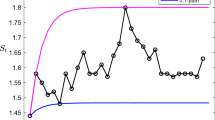Abstract
We review recent European warrant pricing theory that accounts for other securities in the capital structure of the firm, besides the stock and a warrant. An individual who owns a European warrant determines his exercise policy in equilibrium taking into account any transfer of wealth between stockholders and holders of other non-expiring securities. As a result, the equilibrium exercise policy differs from the textbook call-like policy. The equilibrium exercise policy depends on the direction of wealth transfer. We derive the competitive equilibrium policy and demonstrate how it can be computed.
Similar content being viewed by others
References
Bergman Y. Z., Grundy B. D., Wiener Z. (1996) General properties of option prices. Journal of Finance 51(5): 1573–1610
Brennan M., Schwarz E. S. (1977) Convertible bonds: Valuation and optimal strategies for call and conversion. Journal of Finance 32: 1669–1715
Buhler W., Koziol C. (2002) Valuation of convertible bonds with sequential conversion. Schmalenbach Business Review 54: 302–334
Constantinides G. (1984) Warrant exercise and bond conversion in competitive markets. Journal of Financial Economics 13: 371–397
Constantinides G., Rosenthal R. (1984) Strategic analysis of the competitive exercise of certain financial options. Journal of Economic Theory 32: 128–138
Darsinos, T., & Satchell, S. (2002). On the valuation of warrants and executive stock options: Pricing formulae for firms with multiple warrants/executive options. Working paper, University of Cambridge.
Dennis, J. P., & Rendleman, R.J. (2003). A model for valuing multiple executive stock options issued by the same company. Working paper, University of Virginia.
Emanuel D. (1983) Warrant valuation and exercise strategy. Journal of Financial Economics 12: 211–235
Galai D., Schneller M. I. (1978) Pricing of warrants and the value of the firm. Journal of Finance 33: 1333–1342
Grenadier S. (2002) Option exercise games: An application to the equilibrium strategies of firms. Review of Financial Studies 15(3): 691–721
Green R. (1984) Investment incentives, debt and warrants. Journal of Financial Economics 13: 115–136
Heston S. (1993) A closed form solution for options with stochastic volatility with applications to bond and currency options. Review of Financial Studies 6(2): 327–343
Ingersoll J. (1977) A contingent-claims valuation of convertible securities. Journal of Financial Economics 4: 289–322
Ingersoll J. (1987) Theory of Financial Decision Making. Rowman and Littlefield, NJ
Koziol C. (2006) Optimal exercise strategies for corporate warrants. Quantitative Finance 6: 37–54
Lewis C. (1991) Convertible debt: Valuation and conversion in complex capital structures. Journal of Banking and Finance 15: 665–682
Linder, T., & Trautmann, S. (2007). Sequential warrant exercise in large trader economies. working paper, University of Mainz.
Mayers D. (1998) Why firms issue convertible bonds: The matching of financial and real investment options. Journal of Financial Economics 47: 83–102
Merton R. (1974) On the pricing of corporate debt: The risk structure of interest rates. Journal of Finance 29: 449–470
Schulz U. G., Trautmann S. (1994) Robustness of option-like warrant valuation. Journal of Banking and Finance 18(5): 841–859
Spatt C. S., Sterbenz F. P. (1988) Warrant exercise, dividends and reinvestment policy. Journal of Finance 43: 493–506
Stein J. C. (1992) Convertible bonds as backdoor equity financing. Journal of Financial Economics 32: 3–21
Author information
Authors and Affiliations
Corresponding author
Additional information
Nikunj Kapadia—The paper has benefited from comments of N. Chidambaran, Hossein Kazemi, George Martin, Sanjay Nawalkha, N. R. Prabhala, Raghu Sundaram, seminar participants at Georgetown University, University of Maryland, and the University of Virgina. I thank Xiaoling Pu for computational assistance. The paper includes results that were previously circulated in a paper titled Dilution and the Valuation of Options and Non-Identical Warrants.
Rights and permissions
About this article
Cite this article
Kapadia, N., Willette, G. Equilibrium exercise of European warrants. Rev Deriv Res 15, 129–156 (2012). https://doi.org/10.1007/s11147-011-9072-7
Published:
Issue Date:
DOI: https://doi.org/10.1007/s11147-011-9072-7




